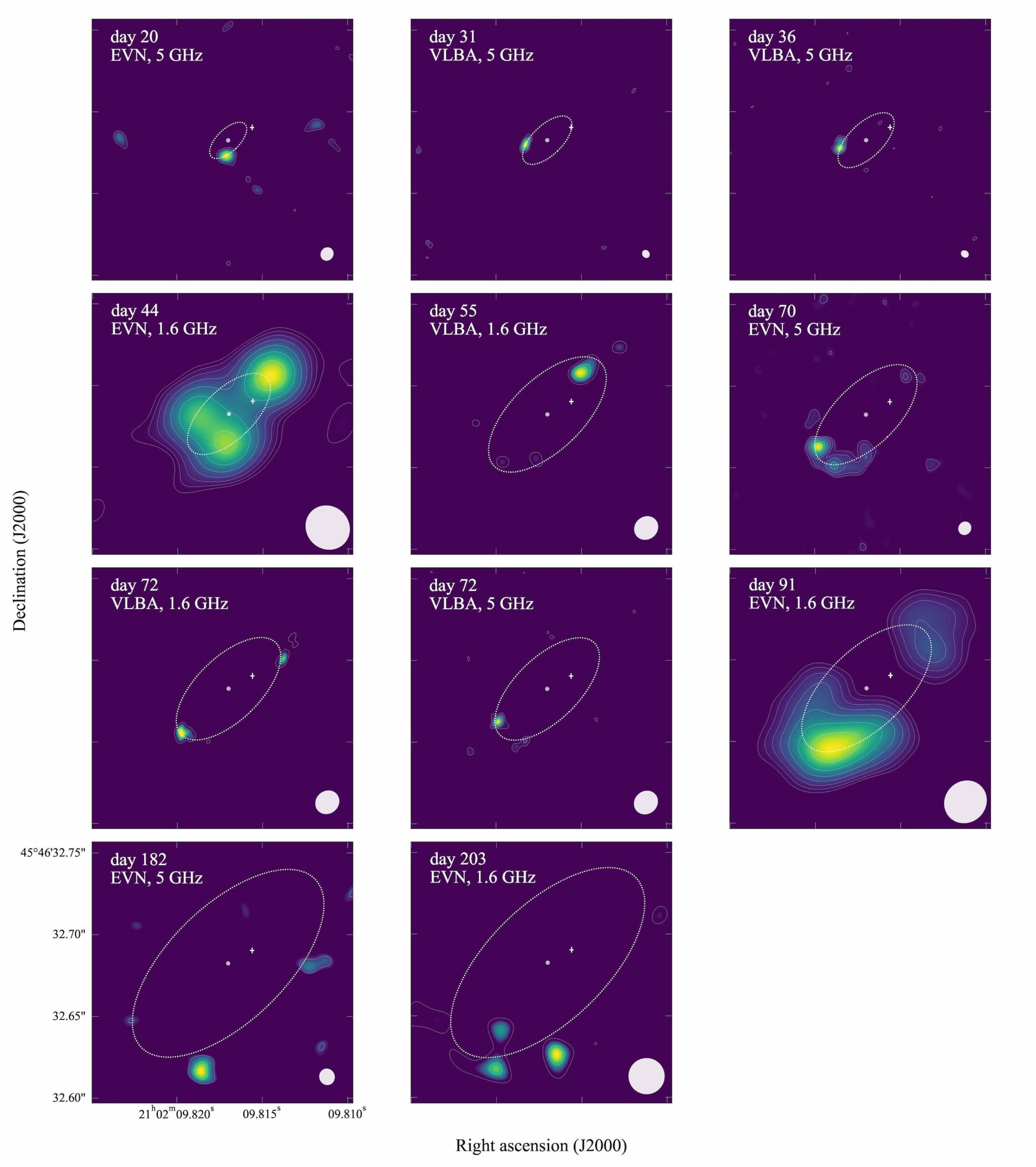

The set of images obtained from the observations, starting 20 days after the discovery of the nova event and tracking the advancement of the shock front for more than six months. Credit: European Space Agency
An international group of researchers observed a source of variable gamma rays identified in 2010 by NASA’s Fermi satellite. They used a technique called VLBI, which combines data from various radio telescopes on Earth, to produce the sharpest images to date. Surprisingly, the source of the gamma rays was a symbiotic nova, a peculiar star system known to astronomers as V407 Cyg. The result, with first author Marcello Giroletti (National Institute of Astrophysics INAF, Italy), was presented at the annual meeting of the European Astronomical Society (EAS) and was published in Astronomy and astrophysics.
Star systems like V407 Cygni were not known to emit very high-energy radiation, so with the 2010 observations, Fermi identified the first member of a new class of gamma objects. Astronomers have now published the results of their VLBI campaign carried out during the spectacular gamma-ray explosion. The images, compiled using radio waves detected by telescopes in Europe and the United States, are the most detailed to date. They reveal the consequences of a powerful cosmic explosion due to the interaction of two stars in close orbit.
Symbiotic novae are rare and rare objects, pairs of stars made up of two very different companions: a small, dense white dwarf and a pulsating red giant. The red giant emits a wind of material that accumulates on the surface of the white dwarf and, when it reaches a critical density, causes a very bright explosion.
While symbiotic novae are rare objects in themselves, observing a symbiotic nova like V407 Cygni in gamma rays was an absolute breakthrough. The researchers then searched for evidence indicating the presence of shocks, passing through the material in the form of shock waves, due to the very energetic physical processes involved in the event. Never before have detailed images of the radio band revealed the impact produced by the explosion of the material on the surface of the white dwarf as it expands in the atmosphere of the red giant companion.
“Novae, with its sudden increases in visible light emission, has fascinated astronomers for centuries and its gamma-ray disclosure has come as a great surprise,” says Giroletti. “Having been able to witness, thanks to radio waves, not only the increase in brightness, but also the choreography produced by the interaction of these two stars is a very exciting result and of great scientific value.”
The new observations were possible thanks to the very high level of detail obtained in the radio band by the VLBI (Very Long Baseline Interferometry) technique, which allowed the appearance and propagation of the shock to be directly visualized.
While directly demonstrating the presence of shock for the first time in these types of events, the researchers were also able to understand how the source is oriented: the red giant is in the foreground against the white dwarf, and from the last two opposite jets depart , in the plane of the sky, perpendicular to the line of sight.
The observations also allowed the researchers to reveal traces of previous events in the life of this binary star, one around 2003, one that even dates back to the 1930s. A step forward in understanding the evolution of these rare objects.
These results are the result of an intense and ambitious observation campaign. Data from the European VLBI Network (EVN) was transmitted in real time to the central data processor (correlator) at JIVE, a European Research Infrastructure Consortium in Dwingeloo, The Netherlands. A supercomputer combined the data obtained simultaneously from all the antennas on the network, and this allowed the researchers to immediately understand that this was truly an unmissable event.
Seeing the light: the study finds a new way for novas to light up the sky
M. Giroletti et al. Very long baseline interferometry image of advanced ejection in the first gamma ray nova V407 Cygni, Astronomy and astrophysics (2020). DOI: 10.1051 / 0004-6361 / 202038142
Provided by the European Space Agency
Citation: The radio telescope array reveals an explosion on the surface of a hot dead star (June 29, 2020) recovered on June 29, 2020 from https://phys.org/news/2020-06-array-radio-telescopes -reveals-explosion. html
This document is subject to copyright. Other than fair dealing for private research or study purposes, no part may be reproduced without written permission. The content is provided for informational purposes only.